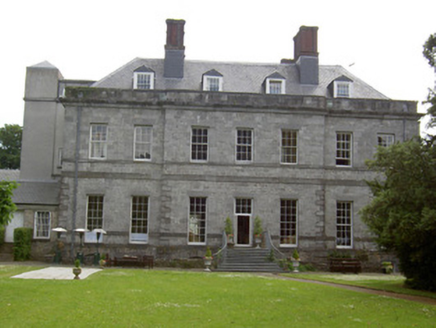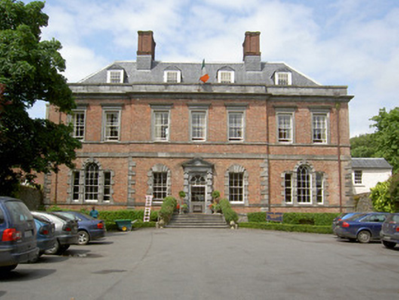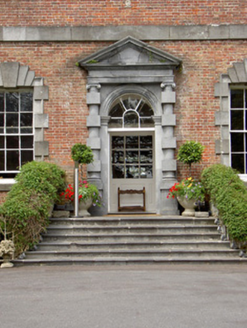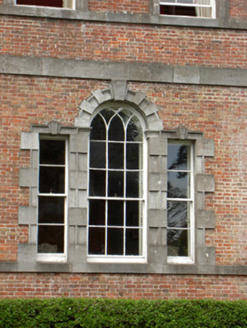Survey Data
Reg No
22105030
Rating
National
Categories of Special Interest
Architectural, Artistic, Historical, Social
Original Use
Bishop's palace
In Use As
Hotel
Date
1730 - 1735
Coordinates
207562, 140617
Date Recorded
01/07/2005
Date Updated
--/--/--
Description
Detached seven-bay two-storey over half-basement former bishop's palace with dormer attic windows, built 1732, now in use as hotel, having two principal elevations with three-bay breakfronts. Multiple-bay two-storey addition to southwest with two-bay two-storey link to house and with two-bay two-storey and three-bay single-storey additions to northeast. Recent lift tower extension to northeast. Hipped slate roof to main house with brick chimneystacks having decorative brick pilasters and slate-hung lower parts, dressed limestone parapet walls, carved limestone dentillated cornice, cast-iron rainwater goods and having gable-fronted dormer windows to both principal elevations. Flemish bond red brick walls to front elevation with dressed limestone plat-band between floors, sill courses, dressed limestone quoins to ground floor and carved limestone string course above rubble limestone basement walls. Roughly dressed limestone walls to rear and side elevations with similar dressings to front elevation. Timber sliding sash windows throughout, with Serlian windows to front ground floor end bays and square-headed elsewhere. Dormer windows are eight-over-eight pane with slate-hung gables above. Front façade ground and first floor windows are six-over-six pane, first floor having, carved limestone surrounds and ground cornices and ground floor having carved limestone Gibbsian surrounds with carved limestone voussoirs and keystones. Serlian windows have carved limestone Gibbsian surrounds and decorative triple keystones to all lights, carved limestone imposts and traceried fanlights. Rear façade ground and first floors have flush dressed limestone surrounds and lintels to windows, six-over-six pane to first floor and nine-over-nine pane to ground floor. Segmental-arch openings to half-basement with limestone voussoirs and replacement timber windows. Front entrance doorway approached by flight of carved limestone steps with cast-iron railings and comprises timber panelled double-leaf door, spoked fanlight, and doorcase. Latter comprises carved limestone pilasters with carved limestone archivolt and flanked by carved limestone engaged rusticated Ionic columns with carved limestone architrave, fascia and dentillated pediment. Garden façade doorway has flush dressed limestone surround and lintel with square-headed timber panelled double-leaf doors and over-light, approached by sweeping flight of carved limestone steps with cast-iron railings. Link building to southwest has brick walls, flat roof and elliptical-headed opening with render surround and voussoirs and recessed replacement timber door. Northeast additions have pitched artificial slate roofs with roughcast and rubble limestone walls with six-over-six pane sliding sash windows, barred to northernmost building. Building retains many interior features. Forecourt to building has former school and gate lodge facing each other inside entrance gates. Gates comprise carved limestone piers flanking vehicular and pedestrian entrances, with carved limestone caps and plinths and cast-iron gates, latter surviving only to pedestrian entrances. Gardens to rear with specimen eighteenth-century mulberry trees.
Appraisal
Designed by Edward Lovett Pearce for Timothy Godwin, this Palladian-style building is of considerable historical importance as the residence of the Church of Ireland archbishops of Cashel and the successor to their medieval quarters on St Patrick’s Rock (Rock of Cashel). Its form is enhanced by the carved limestone dressings. Much emphasis is placed upon symmetry, the triple openings to the central bays being mirrored by the Serlian windows of the end bays. While the rear façade mirrors the front, it offers variety of texture and materials. The forecourt, facing the most central part of Main Street, together with the associated school and gate lodge, and the gardens to the rear at the foot of the Rock with its specimen trees, provide a high-quality setting to the building. The former palace and its associated buildings and grounds, and its relationship with both St Patrick’s Rock and the Church of Ireland Cathedral on John Street, towards both of which it looks, makes up one of the most significant architectural ensembles in Ireland.







